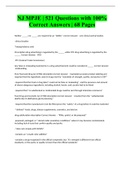Exam (elaborations)
NJ MPJE | 521 Questions with 100% Correct Answers | 68 Pages
- Course
- Institution
Neither _____ nor _____ are required by an *ANDA*. - -pre-clinical animal studies -clinical studies *bioequivalence only Prescription drug advertising is regulated by the _____, while OTC dru g advertising is regulated by the _____. - -FDA -FTC (Federal Trade Commission) Any false or misleading sta...
[Show more]



